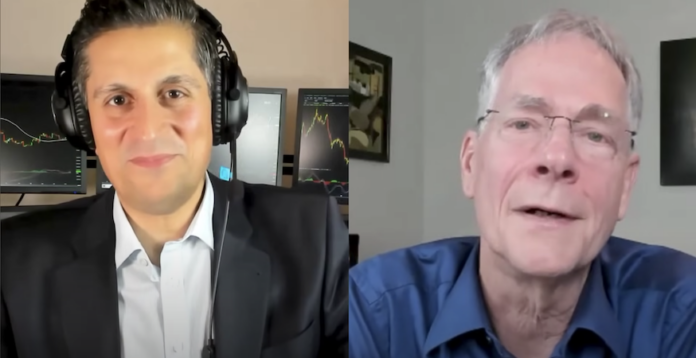Join Our Telegram channel to stay up to date on breaking news coverage
The crypto world, particularly Bitcoin, has been a hotbed of speculation and investment, with its trajectory often being unpredictable. Renowned analyst Robert Prechter recently discussed this topic, in an interview with known trader Alessio Rastani. He provided valuable insights into Bitcoin’s past performance and future prospects.
Prechter began by explaining how Bitcoin, initially a practical concept, evolved into a focal point of investment and speculation. He emphasized the role of socionomic causality in this shift, where traders’ herd mentality and psychological reinforcement play a significant role. This transition marked Bitcoin’s journey from a practical tool to a speculative asset.
He traced Bitcoin’s history, noting its phenomenal growth from a mere penny to a peak of $70,000 – a staggering 7 million times increase. This growth surpassed historic speculative events like the Tulip Mania of the 1600s. Prechter pointed out that during Bitcoin’s rise, it became detached from economic fundamentals, driven instead by waves of social mood and speculative trends.
A critical point in Bitcoin’s timeline, according to Prechter, was January 2022, coinciding with the peak of major stock indices like the Dow Jones and S&P. He suggested that this marked the end of Bitcoin’s bull market, aligning with the broader financial market trends. Prechter’s analysis delved into the Elliott Wave Theory, a method of predicting market movements, which he has mastered over the years. This theory suggests that markets move in predictable patterns of waves, typically in five upward moves followed by three downward corrections.
Looking ahead, Prechter expressed concerns about Bitcoin’s future, especially given the limitations of its underlying blockchain technology. He warned that if a more efficient cryptocurrency were developed, Bitcoin could potentially lose its value, even dropping to zero. This perspective casts a shadow on Bitcoin’s future, especially for those heavily invested in it.
Prechter’s son, Elliott, who played a crucial role in bringing Bitcoin to his attention, contributed to the early coverage of Bitcoin in the Elliott Wave newsletter. This early endorsement at a time when Bitcoin was valued at six cents showcases the foresight and innovative thinking of the Prechters.
Prechter’s analysis presented a sobering view of Bitcoin’s future. He suggests that Bitcoin, now in a bear market, could face significant challenges ahead, especially if a more efficient crypto emerges.
News, Fundamentals or Technicals?
In a follow-up interview with Rastani, Prechter challenges the common belief that market movements in stocks, Bitcoin, or other financial markets are primarily driven by news and fundamental factors like Federal Reserve actions. This viewpoint, widely held by the public and perpetuated by financial media, is critically examined.
Prechter, leveraging insights from his books “The Socionomic Theory of Finance” and “Conquer the Crash”, argues that market movements are not as closely tied to news and fundamentals as many believe. To illustrate this point, the video presents historical examples, including the 2008 financial crisis and the 2020 market crash. Despite interventions by the Federal Reserve and the government, markets continued their downward trajectory, contradicting the belief that these entities can control market bottoms.
The video further dissects the ‘Potent Director Assumption’ – the idea that powerful entities like the Federal Reserve and government can significantly influence market movements. Prechter emphasizes that this assumption is flawed, and market movements are often not correlated with significant news events. Comprehensive studies cited in his book support this, showing that major market movements often occur independently of notable news.
Another crucial aspect discussed is the role of social mood in driving market actions. Prechter suggests that the Federal Reserve and other entities often react to market movements rather than causing them. This perspective is a stark contrast to the popular belief that these bodies proactively shape market trends.
The video also delves into the psychological aspects of market behavior, discussing how emotions and sentiment play a crucial role. Examples from the 2020 market crash illustrate how extreme fear and capitulation among investors and traders can lead to significant market movements, independent of external news or interventions.
Related News
New Crypto Mining Platform – Bitcoin Minetrix
- Audited By Coinsult
- Decentralized, Secure Cloud Mining
- Earn Free Bitcoin Daily
- Native Token On Presale Now – BTCMTX
- Staking Rewards – Over 100% APY
Join Our Telegram channel to stay up to date on breaking news coverage
Credit: Source link






















 Bitcoin
Bitcoin  Ethereum
Ethereum  Tether
Tether  Solana
Solana  USDC
USDC  Lido Staked Ether
Lido Staked Ether  XRP
XRP  Dogecoin
Dogecoin  Toncoin
Toncoin  Cardano
Cardano  Shiba Inu
Shiba Inu  Avalanche
Avalanche  TRON
TRON  Wrapped Bitcoin
Wrapped Bitcoin  Bitcoin Cash
Bitcoin Cash  Polkadot
Polkadot  Chainlink
Chainlink  NEAR Protocol
NEAR Protocol  Polygon
Polygon  Litecoin
Litecoin  Internet Computer
Internet Computer  Uniswap
Uniswap  LEO Token
LEO Token  Dai
Dai  First Digital USD
First Digital USD  Ethereum Classic
Ethereum Classic  Aptos
Aptos  Hedera
Hedera  Stacks
Stacks  Cronos
Cronos  Mantle
Mantle  Filecoin
Filecoin  Stellar
Stellar  Renzo Restaked ETH
Renzo Restaked ETH  Cosmos Hub
Cosmos Hub  OKB
OKB  XT.com
XT.com  Render
Render  Immutable
Immutable  Pepe
Pepe  Arbitrum
Arbitrum  dogwifhat
dogwifhat  Wrapped eETH
Wrapped eETH  Bittensor
Bittensor  Maker
Maker  Optimism
Optimism  The Graph
The Graph 
